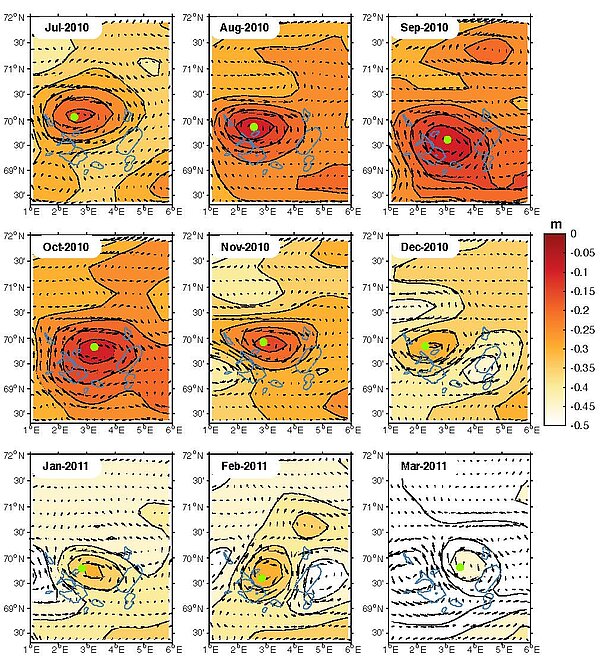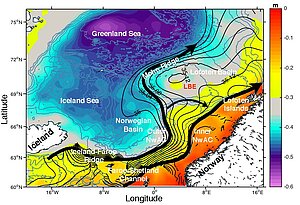Turning around in the Lofoten eddy
Image of the Month - June 2016


The Lofoten basin in the Nordic Seas is a crucial component of the Atlantic thermohaline circulation. It is fed by warm and salty North Atlantic Waters from the inner branch of the Norwegian Atlantic current. This branch goes unstable where the escarpment in bathymetry becomes exceptionally steep off the Lofoten Islands. This leads to frequent shedding of anticyclonic eddies, which then drift westward towards the interior of the Lofoten basin where they maintain the deep Atlantic Water layer structure. These eddies feed a strong anticyclonic eddy residing in the deepest part of the basin.
The anticyclonic Lofoten Basin eddy wanders about in a topographically limited region. Five surveys of the Lofoten Basin Eddy clearly reveal a well-defined coherent structure with an anticyclonically rotating core. The first nine months of a underwater float trajectory, while it was still trapped in the eddy, reveal a stably rotating core with no disruption in its orbital motion. It indicates that the core of the Lofoten Basin Eddy remains quite stable, almost immune or isolated from its interactions with the surrounding waters.
Both historical hydrographic data and altimetry now reveal that the Lofoten Basin eddy is a stable, persistent feature of the Lofoten Basin and has, quite possibly, existed for millennia. Thus, despite its small size, it plays a key role in the circulation of the Nordic Seas.
Altimetry enables to look back at phenomena for nearly 25 years now. With in situ comparisons, long-term monitoring, the ocean features are better and better known. With Jason-3 and Sentinel-3, the uninterrupted series is being continued, and new results will come from these long observations.
See also:
- Image of the Month, July 2012: North Atlantic Subpolar front shifts
- Image of the Month, February 2012: Up North
- Applications: Ocean large-scale circulation
- Applications: Climate
References:
- H. Søiland, L. Chafik, T. Rossby, 2016: On the long-term stability of the Lofoten Basin Eddy, submitted to J. Geophys. Res.




